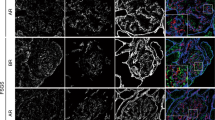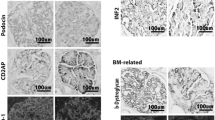Abstract
Background
Urinary CD80 has emerged as potential biomarker in idiopathic nephrotic syndrome (INS). However, its cellular source remains controversial. The aim of the study was to assess whether CD80 is truly expressed by glomerular cells in INS patients during relapse and in the LPS mouse model of podocyte injury.
Methods
The presence of CD80 in glomeruli was evaluated by combining immunostaining, immunogold labeling, and in situ hybridization techniques.
Results
CD80 was present along the surface of glomerular endothelial cells (GEC) and rarely in podocytes in six of nine minimal change disease (MCD) patients in relapse, two of eleven patients with focal segmental glomerulosclerosis in relapse, and absent in controls. In mice, CD80 was upregulated at mRNA and protein level in GEC and podocytes, in a similar pattern to that seen in MCD patients.
Conclusions
Glomerular endothelial cells and podocytes can express CD80 in patients with MCD during relapse. A better understanding of the role of CD80 in glomerular cells may provide further insights into the mechanisms of proteinuria in INS.




Similar content being viewed by others
References
Barisoni L, Schnaper HW, Kopp JB (2007) A proposed taxonomy for the podocytopathies: a reassessment of the primary nephrotic diseases. CJASN 2(3):529–542
Vivarelli M, Massella L, Ruggiero B, Emma F (2017) Minimal change disease. CJASN 12(2):332–345. https://doi.org/10.2215/CJN.05000516
Colucci M, Corpetti G, Emma F, Vivarelli M (2018) Immunology of idiopathic nephrotic syndrome. Pediatr Nephrol 33(4):573–584. https://doi.org/10.1007/s00467-017-3677-5
Reiser J, von Gersdorff G, Loos M, Oh J, Asanuma K, Giardino L, Rastaldi MP, Calvaresi N, Watanabe H, Schwarz K, Faul C, Kretzler M, Davidson A, Sugimoto H, Kalluri R, Sharpe AH, Kreidberg JA, Mundel P (2004) Induction of B7-1 in podocytes is associated with nephrotic syndrome. J Clin Invest 113(10):1390–1397
Ishimoto T, Shimada M, Gabriela G, Kosugi T, Sato W, Lee PY, Lanaspa MA, Rivard C, Maruyama S, Garin EH, Johnson RJ (2013) Toll-like receptor 3 ligand, polyIC, induces proteinuria and glomerular CD80, and increases urinary CD80 in mice. Nephrol Dial Transplant 28(6):1439–1446. https://doi.org/10.1093/ndt/gfs543
Jain N, Khullar B, Oswal N, Banoth B, Joshi P, Ravindran B, Panda S, Basak S, George A, Rath S, Bal V, Sopory S (2016) TLR-mediated albuminuria needs TNFalpha-mediated cooperativity between TLRs present in hematopoietic tissues and CD80 present on non-hematopoietic tissues in mice. Dis Model Mech 9(6):707–717. https://doi.org/10.1242/dmm.023440
Rivard CJ, Tanabe T, Lanaspa MA, Watanabe H, Nomura S, Andres-Hernando A, Garth K, Sekijima M, Ishimoto T, Ariyoshi Y, Garcia GE, Shah J, Lennan B, Tasaki M, Pomposelli T, Shimizu A, Sachs DH, Johnson RJ, Yamada K (2018) Upregulation of CD80 on glomerular podocytes plays an important role in development of proteinuria following pig-to-baboon xeno-renal transplantation - an experimental study. Transpl Int 31(10):1164–1177. https://doi.org/10.1111/tri.13273
Shimada M, Ishimoto T, Lee PY, Lanaspa MA, Rivard CJ, Roncal-Jimenez CA, Wymer DT, Yamabe H, Mathieson PW, Saleem MA, Garin EH, Johnson RJ (2012) Toll-like receptor 3 ligands induce CD80 expression in human podocytes via an NF-kappaB-dependent pathway. Nephrol Dial Transplant 27(1):81–89. https://doi.org/10.1093/ndt/gfr271
Gurkan S, Cabinian A, Lopez V, Bhaumik M, Chang JM, Rabson AB, Mundel P (2013) Inhibition of type I interferon signalling prevents TLR ligand-mediated proteinuria. J Pathol 231(2):248–256
Yu CC, Fornoni A, Weins A, Hakroush S, Maiguel D, Sageshima J, Chen L, Ciancio G, Faridi MH, Behr D, Campbell KN, Chang JM, Chen HC, Oh J, Faul C, Arnaout MA, Fiorina P, Gupta V, Greka A, Burke GW 3rd, Mundel P (2013) Abatacept in B7-1-positive proteinuric kidney disease. N Engl J Med 369(25):2416–2423. https://doi.org/10.1056/NEJMoa1304572
Garin EH, Diaz LN, Mu W, Wasserfall C, Araya C, Segal M, Johnson RJ (2009) Urinary CD80 excretion increases in idiopathic minimal-change disease. J Am Soc Nephrol 20(2):260–266. https://doi.org/10.1681/ASN.2007080836
Garin EH, Mu W, Arthur JM, Rivard CJ, Araya CE, Shimada M, Johnson RJ (2010) Urinary CD80 is elevated in minimal change disease but not in focal segmental glomerulosclerosis. Kidney Int 78(3):296–302. https://doi.org/10.1038/ki.2010.143
Cara-Fuentes G, Wei C, Segarra A, Ishimoto T, Rivard C, Johnson RJ, Reiser J, Garin EH (2014) CD80 and suPAR in patients with minimal change disease and focal segmental glomerulosclerosis: diagnostic and pathogenic significance. Pediatr Nephrol 29(8):1363–1371. https://doi.org/10.1007/s00467-013-2679-1
Cara-Fuentes G, Wasserfall CH, Wang H, Johnson RJ, Garin EH (2014) Minimal change disease: a dysregulation of the podocyte CD80-CTLA-4 axis? Pediatr Nephrol 29(12):2333–2340. https://doi.org/10.1007/s00467-014-2874-8
Ling C, Liu X, Shen Y, Chen Z, Fan J, Jiang Y, Meng Q (2015) Urinary CD80 levels as a diagnostic biomarker of minimal change disease. Pediatr Nephrol 30(2):309–316. https://doi.org/10.1007/s00467-014-2915-3
Mishra OP, Kumar R, Narayan G, Srivastava P, Abhinay A, Prasad R, Singh A, Batra VV (2017) Toll-like receptor 3 (TLR-3), TLR-4 and CD80 expression in peripheral blood mononuclear cells and urinary CD80 levels in children with idiopathic nephrotic syndrome. Pediatr Nephrol 32(8):1355–1361. https://doi.org/10.1007/s00467-017-3613-8
Bhatia D, Sinha A, Hari P, Sopory S, Saini S, Puraswani M, Saini H, Mitra DK, Bagga A (2018) Rituximab modulates T- and B-lymphocyte subsets and urinary CD80 excretion in patients with steroid-dependent nephrotic syndrome. Pediatr Res 84(4):520–526. https://doi.org/10.1038/s41390-018-0088-7
Ling C, Liu X, Shen Y, Chen Z, Fan J, Jiang Y, Meng Q (2018) Urinary CD80 excretion is a predictor of good outcome in children with primary nephrotic syndrome. Pediatr Nephrol 33(7):1183–1187. https://doi.org/10.1007/s00467-018-3885-7
Garin EH, Reiser J, Cara-Fuentes G, Wei C, Matar D, Wang H, Alachkar N, Johnson RJ (2015) Case series: CTLA4-IgG1 therapy in minimal change disease and focal segmental glomerulosclerosis. Pediatr Nephrol 30(3):469–477. https://doi.org/10.1007/s00467-014-2957-6
Isom R, Shoor S, Higgins J, Cara-Fuentes G, Johnson RJ (2019) Abatacept in steroid-dependent minimal change disease and CD80-uria. Kidney Int Rep 4(9):1349–1353. https://doi.org/10.1016/j.ekir.2019.05.1155
Larsen CP, Messias NC, Walker PD (2014) B7-1 immunostaining in proteinuric kidney disease. Am J Kidney Dis 64(6):1001–1003. https://doi.org/10.1053/j.ajkd.2014.07.023
Novelli R, Gagliardini E, Ruggiero B, Benigni A, Remuzzi G (2016) Any value of podocyte B7-1 as a biomarker in human MCD and FSGS? Am J Physiol Renal Physiol 310(5):F335–F341. https://doi.org/10.1152/ajprenal.00510.2015
Lee SW, Baek SH, Paik JH, Kim S, Na KY, Chae DW, Chin HJ (2017) Tubular B7-1 expression parallels proteinuria levels, but not clinical outcomes in adult minimal change disease patients. Sci Rep 7:41859. https://doi.org/10.1038/srep41859
Alwadhi RK, Mathew JL, Rath B (2004) Clinical profile of children with nephrotic syndrome not on glucorticoid therapy, but presenting with infection. J Pediatr Child Health 40(1–2):28–32
Cleuren ACA, van der Ent MA, Jiang H, Hunker KL, Yee A, Siemieniak DR, Molema G, Aird WC, Ganesh SK, Ginsburg D (2019) The in vivo endothelial cell translatome is highly heterogeneous across vascular beds. Proc Natl Acad Sci U S A 116(47):23618–23624. https://doi.org/10.1073/pnas.1912409116
Minamikawa S, Nozu K, Maeta S, Yamamura T, Nakanishi K, Fujimura J, Horinouchi T, Nagano C, Sakakibara N, Nagase H, Shima H, Noda K, Ninchoji T, Kaito H, Iijima K (2018) The utility of urinary CD80 as a diagnostic marker in patients with renal diseases. Sci Rep 8(1):17322. https://doi.org/10.1038/s41598-018-35798-227
Wang P, Zhou S, Ge Y, Lu M, Liu Z, Gong R (2017) Valproate hampers podocyte acquisition of immune phenotypes via intercepting the GSK3beta facilitated NFkB activation. Oncotarget 8(51):88332–88344. https://doi.org/10.18632/oncotarget.19917
Baye E, Gallazzini M, Delville M, Legendre C, Terzi F, Canaud G (2016) The costimulatory receptor B7-1 is not induced in injured podocytes. Kidney Int 90(5):1037–1044. https://doi.org/10.1016/j.kint.2016.06.022
Chen W, Wu Y, Zhang G, Wang M, Yang H, Li Q (2018) GammadeltaT cells exacerbate podocyte injury via the CD28/B7-1-phosphor-SRC kinase pathway. Biomed Res Int:5647120. https://doi.org/10.1155/2018/5647120
Khullar B, Balyan R, Oswal N, Jain N, Sharma A, Abdin MZ, Bagga A, Bhatnagar S, Wadhwa N, Natchu UCM, George A, Rath S, Bal V, Sopory S (2018) Interaction of CD80 with Neph1: a potential mechanism of podocyte injury. Clin Exp Nephrol 22(3):508–516. https://doi.org/10.1007/s10157-017-1489-3
MacDonald NE, Wolfish N, McLaine P, Phipps P, Rossier E (1986) Role of respiratory viruses in exacerbations of primary nephrotic syndrome. J Pediatr 108(3):378–382
Tkaczyk M, Czupryniak A, Owczarek D, Lukamowicz J, Nowicki M (2008) Markers of endothelial dysfunction in children with idiopathic nephrotic syndrome. Am J Nephrol 28(2):197–202
Sharma B, Saha A, Dubey NK, Kapoor K, Anubhuti BVV, Upadhayay AD (2014) Endothelial dysfuntion in children with idiopathic nephrotic syndrome. Atherosclerosis 233(2):704–706. https://doi.org/10.1016/j.atherosclerosis.2014.01.055
Chaves MMS, Mendes MS, Schwermann MP, Queiroz R, Coelho RF, Salmito FTS, Meneses GC, Martins AMC, Moreira ACOM, Libório AB (2018) Angiopoietin-2: a potential mediator of the glycocalyx injury in adult nephrotic patients. J Clin Med 7(11). https://doi.org/10.3390/jcm7110401
Ohl K, Eberhardt C, Spink C, Zahn K, Wagner N, Eggermann T, Kemper MJ, Querfeld U, Hoppe B, Harendza S, Tenbrock K (2014) CTLA4 polymorphisms in minimal change nephrotic syndrome in children: a case-control study. Am J Kidney Dis 63(6):1074–1075. https://doi.org/10.1053/j.ajkd.2014.01.427
Benz K, Buttner M, Dittrich K, Campean V, Dotsch J, Amann K (2010) Characterisation of renal immune cell infiltrates in children with nephrotic syndrome. Pediatr Nephrol 25(7):1291–1298. https://doi.org/10.1007/s00467-010-1507-0
Uchida K, Suzuki K, Iwamoto M, Kawachi H, Ohno M, Horita S, Nitta K (2008) Decreased tyrosine phosphorylation of nephrin in rat and human nephrosis. Kidney Int 73(8):926–932. https://doi.org/10.1038/ki.2008.19
Acknowledgments
We thank Dr. Eduardo H Garin for his suggestions.
Funding
This study was supported by NIH K12 HD028820-27 to GCF.
Author information
Authors and Affiliations
Corresponding author
Ethics declarations
Conflict of interest
The authors declare that they have no conflict of interest.
Additional information
Publisher’s note
Springer Nature remains neutral with regard to jurisdictional claims in published maps and institutional affiliations.
Electronic supplementary material
ESM 1
(PPTX 191 kb)
Rights and permissions
About this article
Cite this article
Cara-Fuentes, G., Venkatareddy, M., Verma, R. et al. Glomerular endothelial cells and podocytes can express CD80 in patients with minimal change disease during relapse. Pediatr Nephrol 35, 1887–1896 (2020). https://doi.org/10.1007/s00467-020-04541-3
Received:
Revised:
Accepted:
Published:
Issue Date:
DOI: https://doi.org/10.1007/s00467-020-04541-3




